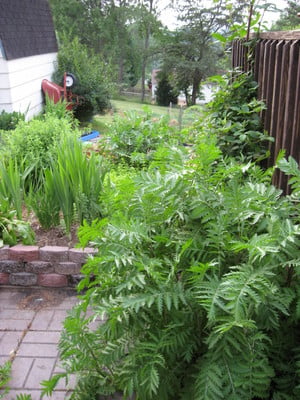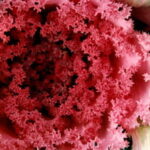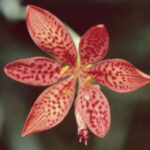Tansy (Tanacetum vulgare) is a perennial herb native to Europe and hardy to Zone 4. It has had some culinary uses, primarily as a substitute for pepper. However, it was used sparingly due to its strong flavor and the fact that it can be toxic. Tansy can also be quite invasive when planted in the garden. Given its toxicity and its invasiveness, you might wonder why anyone would choose to include tansy in the landscape. It does, however, have much to lend itself to such inclusion.
Tansy actually has some ornamental purposes. It looks like a fern – a fern that thrives in full sun. It can also be quite impressive as a specimen plant, growing to be 3-4 feet tall and can turn into quite an notable bush. It has yellow flowers, which remind me a bit of yarrow; however, I tend to cut these back to encourage a bushier growth. If you decide to plant tansy in the ground, I would recommend that you establish a barrier about 2-feet deep or leave it in a plastic pot that is planted directly into the ground. (I cannot stress enough just how invasive this herb can be!) You can also grow tansy in containers, which eliminates the problem of its taking over your garden.
As far as using tansy as a culinary ingredient, I would recommend against it. (Experienced herbalists might feel comfortable cooking with tansy, but the average person should steer clear.) First, tansy does have a very strong flavor. Secondly, large quantities can prove harmful and even fatal. Determining the quantity that would be safe can be difficult, since each plant can be different in its potency. Therefore, you should “just say no” to cooking with tansy.
The main reason, however, that I decided to use tansy in my own landscape is for its insect-repellent qualities. Tansy, I have found, is quite effective as a mosquito repellent. In fact, I have had no mosquitoes harassing me in the 15 years or more that I have had the herb around, while other homes are plagued by the little blood-suckers. In addition, I have found that tansy works very well at repelling ants in the home. Ants have been a problem in my area. I had tried everything to rid our kitchen of them. I then read that placing sprigs of tansy in cabinets was an old-fashioned remedy for ridding homes of ants. I gave it a try, and the ants went away. You will have to replace the tansy with fresh on a fairly regular basis, but it does really work. Also, you can place a pot of tansy near the door to discourage flies from coming into the house. In the garden, tansy will repel Japanese beetles, Colorado potato beetles, flea beetles, cabbage worms, and squash bugs. (It has an almost piney smell when growing; however, I noticed more of a citronella aroma when I cut it. This could explain, in part, its properties as an insect repellent.)
Tansy is also reputed to be a good companion plant for blackberries and raspberries, encouraging a more rapid growth. While this has not been scientifically proven, I have noticed in my own garden that the blackberry bush planted near my tansy more than tripled in size in a relatively short amount of time while the one near no tansy has exhibited a slower growth pattern.
Tansy is extremely easy to grow and actually quite fool-proof. It does prefer full sun; however, if you would like to control its rampant habits a bit, you can plant it in partial shade. At the end of the season, cut it back hard (whether you have it in the ground or in a container). It will definitely come back the next year. Tansy’s good qualities offset many of its bad, which lends itself to a plant worth having around.




